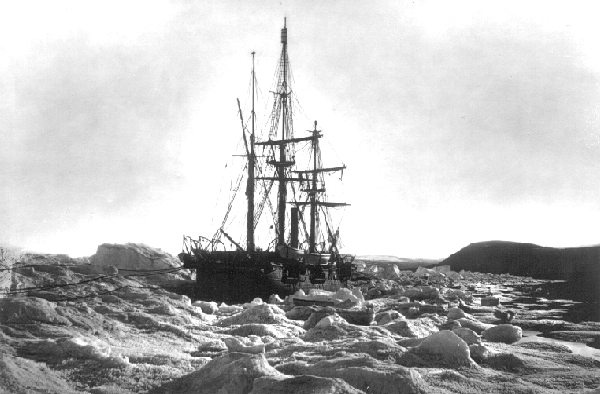1876
Arctic Drift-Wood
A memento from the 1875-6 British Arctic Expedition.
By Alan O'ConnorDescription
In the National Museum of Ireland’s acquisition register (dated September 14th, 1905), the entry for NH:1905.142 reads: Collection of fossil shells; given by Dr Moss, H.M.S Alert; Grinnell Land; fossils from raised beach; 200 ft above sea level, Grinnell Land, given by Dr Moss in 1877 (and registered at the time).
Amongst the lot were several pieces of driftwood, including this one.
The British Arctic Expedition of 1875-6
The British Arctic Expedition, comprised of the ships HMS Alert and HMS Discovery, set sail on May 29th, 1875 with orders to:
On board the HMS Alert (Figure 2) was Dublin-born Dr Edward Lawton Moss (1843-80). Part of the expedition’s medical staff, he also sketched the Arctic landscape and made scientific observations. He illustrated Floeberg beach at around the time the specimen in Figure 1 was collected. The following excerpt from his book refers to Floeberg:…attain the highest northern latitude, and, if possible, to reach the North Pole, and from winter quarters to explore the adjacent coasts within the reach of travelling parties, the limits of ship navigation being confined within about the meridians of 20° and 90° west longitude (Nares, 1878, Vol. 1, p. xi).
A high point of the expedition had been the attainment, on May 12th, 1876, of a landmark ‘furthest north’ by a party under Commander Albert Markham:…though there was no trace of man or his doings, Nature had left deeply significant records of her own to tell the history of the land … the most interesting and eloquent witnesses of the past were the splinters and logs of driftwood that lay' imbedded in the mud, or scattered along the crests of these raised beaches. The wood was easily recognised by the microscope as the wood of pine trees, and though probably very many centuries old, was often so apparently fresh as to smell woody when cut. It was not for us to conjecture when or where that wood had grown, or how it had drifted to its present elevated site; but we could not help thinking that it told of a time when the shores, though perhaps far more deeply laden with glaciers, were washed by a less ice-bound sea (Moss, 1878, p. 71-2).
At noon we obtained a good altitude, and proclaimed our latitude to be 83° 20' 26" N., exactly 399.L miles from the North Pole. On this being duly announced three cheers were given, with one more for Captain Nares ; then the whole party, in the exuberance of their spirits at having reached their turning point, sang the " Union Jack of Old England," the " Grand Palseocrystic Sledging Chorus," winding up, like loyal subjects, with " God save the Queen." These little demonstrations had the effect of cheering the men, who nevertheless enjoy good spirits. The instruments were then packed, the colours furled, and our steps retraced to the camp (Nares, 1878, Vol. 1, p. 377).

How did this Specimen come to be in the Museum?
Unable to reach the North Pole, and suffering increasingly from the harsh climate, the expedition returned to Portsmouth on November 2nd, 1876. The register entry indicates that Dr Moss made his donation the following year.
Learn more
This specimen is part of the Museum’s scientific collection, and is not on public display. Dr Moss’s book recounting the expedition can be found online, as can that by Captain Nares. The book ‘Resurrecting Dr Moss’ by Paul Appleton is a recent biography of the donor.
References
Moss, E.L. (1878). Shores of the Polar Sea. A Narrative of the Arctic Expedition of 1875-6. London: Marcus Ward & Co. Belfast: Ulster Royal Works. Available online.
Nares, G. (1878). Narrative of a voyage to the Polar Sea during 1875-76 in H.M. ships 'Alert' and 'Discovery'. London: Sampson Low, Marston, Searle, and Rivingston. Volume 1 and Volume 2 available online.
BC Studies - The British Columbian Quarterly (2011). Book Reviews. Available at: http://www.bcstudies.com/?q=book-reviews/resurrecting-dr-moss-life-and-letters-royal-navy-surgeon-edward-lawton-moss-md-rn-1843. [Accessed 19 April 2016].
Location:
Arctic Drift-Wood is located at:
In Storage
Previous artefact:
Next artefact:
